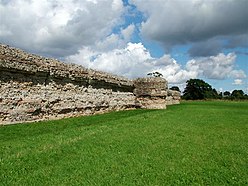Gariannonum
| Gariannonum | |
|---|---|
 Burgh Castle is sometimes identified as Gariannonum | |
| Alternative name(s) | Gariannum |
| Location | |
| Coordinates | 52°34′55″N 1°39′07″E / 52.582°N 1.652°E |
| County | Norfolk |
| Country | England |
| Reference | |
| UK-OSNG reference | TG474045 |
Gariannonum, or Gariannum, was a Saxon Shore fort in Norfolk, England. The Notitia Dignitatum, a Roman Army “order of battle” from about AD 400, lists nine forts of the Saxon Shore in south and east England, among which one was called Gariannonor. It has been much discussed over the years in terms of spelling (Gariannonum, Garianonum, Gariannum), purpose (whether it really was intended for defence against Saxon raids), and location (whether Burgh Castle or the Caister-on-Sea site).[1]
Identification
Gariannonum has usually been identified with Burgh Castle.[2] However, modern reassessment of the Roman settlement 9 kilometres (5.6 mi) away at Caister-on-Sea has shown that it too had a military function.[3] In Roman times, both sites lay on opposite sides of a large estuary (the remnant of which is Breydon Water).[4] The identification of Burgh Castle as Gariannonum is uncertain, and the name could apply to Caister-on-Sea.[3][5]
The name Gariannonum has been thought to derive from a Celtic root meaning "babbling river," which may refer to the River Yare at Burgh Castle, although the derivation is uncertain.[6] The military function of Caister-on-Sea is also open to doubt.[7] Both sites probably operated together and one, or possibly even both, were known by the Romans as Gariannonum.[8]
References
- ^ "Pastscape website article: Burgh Castle". Retrieved 7 May 2011.
- ^ There has long been doubt on the issue. See Henry Swinden, (1772), The history and antiquities of the ancient burgh of Great Yarmouth in the County of Norfolk, page 2: "But where that ancient fortress was situated, authors are not agreed. The generality, with Camden, place it at Burgh-Castle; while others (a), with some probability, think Caister, near Yarmouth, the Gariannonum of the Romans."
- ^ a b Andrew F. Pearson, (2003), The construction of the Saxon Shore Forts, page 10. Archaeopress
- ^ Nic Fields, (2006), Rome's Saxon shore: coastal defences of Roman Britain, AD 250-500, page 28. Osprey
- ^ Garianno Burgh Castle or Caister-on-sea, Suffolk Archived 2007-01-05 at the Wayback Machine, Roman Map, retrieved 18 May 2011
- ^ Jacek Fisiak, Peter Trudgill, (2001), East Anglian English, page 40. Boydell & Brewer
- ^ Roger Wilson, (2002), A Guide to the Roman Remains in Britain, pages 245-6. Constable
- ^ Burgh Castle History and Research, English Heritage - retrieved 18 May 2011
External links
- Burgh Castle, English Heritage
- Caister Roman Site, English Heritage

